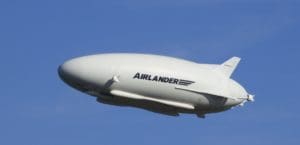
Airships. Maybe it’s just me but whenever I hear that word it’s a grainy black & white newsreel of the Hindenburg spectacularly burning up over New Jersey in 1937 at the end of a transatlantic flight that centers in my mind. So I was intrigued when one of my fellow organizing committee members for the LogiSYM 2017 logistics and supply chain conference in Singapore proposed a session on the newest generation of airships and their relevance to logistics. I clearly was not the only one intrigued, as not only was the proposal unanimously accepted by the committee, the Day 2 keynote presentation by representatives from Airships Arabia and Airships Australasia generated quite a buzz at this year’s conference (May 17-18).
I would guess the reason for that level of interest was hearing about a potential resurgence in a largely unfamiliar form of transportation technology. I certainly learned a lot. For instance, did you know that airships actually pre-date all other aircraft types and the first one flew way back in 1784? That they have been in service continuously since 1901? (Luftschiffbau Zeppelin, manufacturer of the unfortunate Hindenburg, is still around and building airships in Germany today.) That there are more astronauts than qualified airship pilots in the world? And that there is a tangible business case for their use in logistics?
Current airship technology investment is directed towards the development of so-called hybrid airships, which combine the buoyant lift provided by helium (an inert gas unlike the flammable hydrogen used in the Hindenburg) with the aerodynamic lift and vectored engine thrust lift associated with conventional aircraft. The aim is to provide the best of both worlds i.e. marry the low operating costs and take-off/landing location flexibility of conventional airships with the faster speeds, more sophisticated control and higher payload capacities of aeroplanes. The two leading developers of hybrid airships are US aerospace giant Lockheed Martin and the rather less well known Hybrid Air Vehicles, a UK company founded in 2007.
With a volume of 38,000 m3 and maximum payloads of 10,000 kg, the Airlander 10 from Hybrid Air Vehicles made a successful three-hour test flight in England on May 10. The world’s largest aircraft at 92 meters (302 foot) long, the Airlander 10 will undergo certification for both passenger and cargo use. Currently under development is the company’s much larger (volume 103,000 m3, length 119 m, max payload 60,000 kg) Airlander 50, which is slated for cargo-only operations upon commercial launch in the early 2020s.
As for Lockheed Martin, following the development and flight test of the P-791 prototype more than 10 years ago, its first full-scale hybrid airship, with a payload capacity of 25,000 kg, is expected in 2019. Heralding this new aircraft, the company emphasizes its large cargo capacity, low fuel consumption relative to other forms of air transportation, and faster speed than land or sea alternatives. Furthermore, with more than two-thirds of the world’s land area not having direct access to roads or runways, getting to remote locations with road vehicles and conventional aircraft is a challenge, and one that can be overcome through the use of airships.
During his LogiSYM presentation, Gregory Gottlieb, managing director at Airships Arabia, echoed these and other advantages of using hybrid airships for logistics. The fuel needs of airships versus airliners are indeed dramatically different, to the extent that a Boeing 737 burns the same amount of fuel moving from the airport terminal to the runway as an Airlander 10 does on a three-day flight. While air cargo aircraft can carry heavy payloads, the normal operating situation is that they tend to carry bulky but low-weight items such as perishable foods and flowers such that often only a fraction of the payload capacity is utilized. Airships, however, have very large internal volumes for cargo storage, making them suitable for the transport of bigger items. And airships, not needing runway infrastructure and able to take off and land on virtually anywhere and any surface, including water, not only makes their use feasible in remote environments without airports but can also eliminate the need for the intermodal transfers – truck-to-ship-to-truck, etc. – normally required in logistics operations.
Airships Arabia and Airships Australasia are building capabilities to be operators of hybrid airships in their respective regions, with pilot training, maintenance services and spare parts procurement among the activities necessary to support successful operations. Logistics is an identified application along with others such as humanitarian disaster relief, oceanic search and rescue, and even city-to-city passenger transport. With the first service anticipated in either 2020 or 2021, working with civil aviation authorities to ensure the necessary regulations are in place by then is an important element of the companies’ current efforts.
Given that Gregory Gottlieb readily acknowledges that there are five other companies “with the same idea as us” and with the serious efforts of manufacturers like Lockheed Martin and Hybrid Air Vehicles, it will be interesting to see if hybrid airship can find their place in the logistics industry and become a viable cargo transportation mode in the next decade.
Finally, while the developments may not be related, but in the context of airships and logistics, it’s worth recalling last December’s reveal of an Amazon 2014 patent describing an airborne fulfilment center (AFC) that “may be an airship” and from which drones could be dispatched to make deliveries to user-specified locations. While Amazon has not elaborated on its plans for these so-called flying warehouses, the specific mention of airships does indicate a brighter future for these helium filled vessels in the sky.

















For more information on airships, contact Hybrid Pilot Services Ltd.